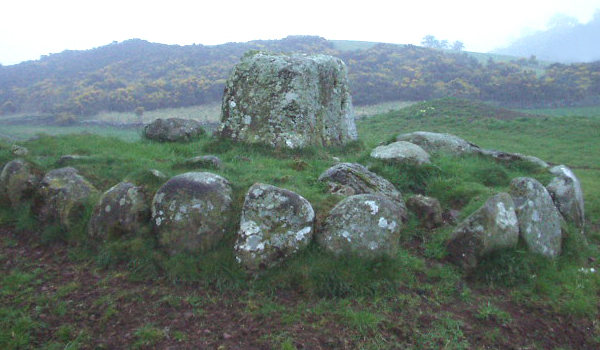

 |
|
Ormiston Hill is just a little way south of Newburgh, and behind it is what remains of
Macduff's Cross. According to tradition it marks the spot where the Thane of Fife passed on
his way to Auchtermuchty while fleeing from Macbeth. It was erected by Malcolm III to
commemorate the death of Macbeth (d.1057). The inscription along with the shaft were destroyed
at the Reformation and only the base remains. Fragments of the original Cross are believed to
be built into some of the nearby houses.
Although badly damaged in 1559 by the Reformers, the cross is still very much a legendary place of sanctuary for all those of the MacDuff clan who had been involved in murder. Such MacDuff clan members could achieve atonement by performing a series of rituals. Having touched the MacDuff stone, they would then wash themselves nine times at nearby Ninewells. They would also have to pay a forfeit of nine cows. All that is remaining of Macduff's Cross is a sandstone boulder about 3ft 3ins high by 3ft 6ins wide, roughly cubical, resting on an earthen platform and surrounded by a setting of smaller stones erected by Newburgh Town Council in 1851. The top, marked with eight distinct cups (formed by the weathering out of nodules of iron pyrites), is slightly hollowed although there is no indication of a socket, despite the story that the cross itself was thrown down and destroyed by Reformers in 1559, and a report in 1727 of a socket. The name, currently in popular use, does not occur in local records until 1814. One historian, Skene, wrote in 1641 of "the Cross of Clan Makduffe" and described the right of sanctuary at the cross for members of the clan. It was described as " our ancient.. march stone" by Sir Thomas Balfour, who died in 1657. Skene saw the stones of the cross inscribed with "sundry barbarous words and verses", which had disappeared by 1648. Another historian, Sibbald, in 1710 recorded the date "1059" and some unintelligible letters from a drawing copied from notes given to Sir James Balfour, (which show a simple outline elevation of a Greek cross on a square base). When the field was first plowed, a "rude sort of pavement" discovered on the hillock, 30 paces south of the cross was thought to be the floor of a cell or oratory associated with the Cross, but no trace of the "pavement" described in 1876 still exists. (Ref.: The Royal Commission on the Ancient and Historical Monuments of Scotland.) |

|
Return to ORMISTONS IN FIFE page |
